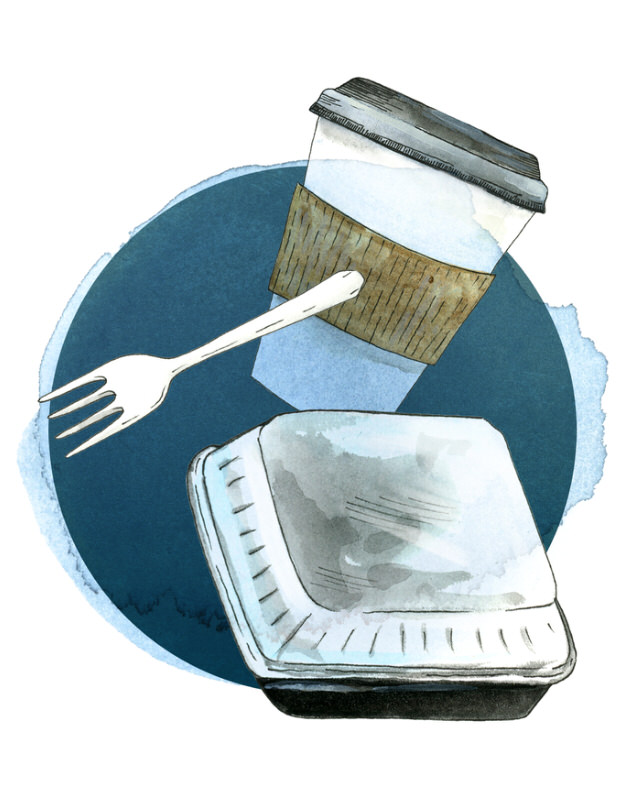In the season of Earth Day, we take a look at the plastic waste epidemic — the overlooked byproduct of COVID’s effect on the food industry.
When we think of coronavirus, we generally focus on the devastating impact it’s had upon our health, lifestyle, jobs, education, economy, and even life’s simple pleasures — family gatherings, eating out, or sharing a drink with friends.
But there’s a dirty little secret about COVID-19 that few of us even realize. It’s not only wreaking havoc on people and society, it’s also inflicting devastating and potentially irreversible damage to the planet. How? By creating a plastic waste explosion of epidemic proportions.
By the Numbers
The amount of plastic waste we generate, even in normal times, already is a major problem. We use a lot plastic. More importantly, we trash a lot of plastic. More than we can handle.
In 2018, pre-COVID-19, National Geographic reported that an astonishing 8.3 billion metric tons of plastic are manufactured globally every year. Of that, a whopping 6.3 billion metric tons become plastic waste. And most alarming: Only 9 percent of plastics ever manufactured are recycled, leaving 91 percent of virtually indestructible, unsightly waste with nowhere to go. Most of it ends up in landfills. Or, even worse, the ocean.

Envision a garbage truck dumping its load of plastic into the ocean every single minute. That’s the equivalent of 8 million metric tons of plastic that ends up swimming with the fishes every year. The Great Pacific Garbage Patch is just one of five plastic accumulation zones in the world’s oceans. Located halfway between California and Hawaii, it covers an area twice the size of Texas, and it’s still growing. In fact, according to Scientific American, models project that if we continue on the current trajectory, there will be more plastic by weight than fish in the oceans by 2050.
To make matters worse, 2020 increased the amount of plastic waste over 2019 by more than 30 percent, largely thanks to coronavirus, the best friend single-use plastics has ever had!
So while we were rejoicing over cleaner air, due to less travel during the pandemic, we were quietly losing ground on another pollution front.
Safety, Sanitation, Survival
Those three words are the mantras that have guided our actions for most of the past year. Unfortunately, each of them came gift wrapped in a whole lot of single-use plastic.
First, of course, is all the necessary PPE (Personal Protective Equipment) required by medical and essential workers. Literally millions of plastic gowns, masks, and gloves are used and trashed daily. That’s unavoidable.
But it might surprise you to know that a large amount of the single-use plastic explosion is generated by us, the average consumer, and our most ubiquitous vendor, the food industry. It’s true. Because of COVID-19 we have changed much about how we handle, market, and procure our daily bread. In the process, we have inadvertently reversed many of the efforts and practices we had adopted to combat plastic waste.
For example, not long ago, consumers were encouraged to bring their own reusable shopping bags to grocery stores, or cups to coffee shops and even rewarded for doing so. Bulk bins provided package-free options to purchase nonperishable foods. Practices such as these resulted in cost savings for vendors and customers, as well as a huge reduction of waste products. Due to contamination fears wrought by the pandemic, those, along with numerous other eco-friendly policies, have largely been rescinded.
Curbside Conundrum
State pandemic regulations restricting dine-in capacity resulted in most restaurants converting to takeout business models in order to survive. This actually caused a huge plastic pollution increase. Think about it: A takeout meal requires items such as disposable containers, cups, bags, utensils, straws, napkins, and individual condiments — most, if not all, non-recyclable.

Even vendors who formerly embraced eco-friendly products and policies were forced to alter or abandon them. Kaya Stanley, co-owner of Reno’s Old Granite Street Eatery and Rounds Bakery, perhaps says it best.
“Unfortunately, more expensive but ecologically friendly takeout material is not something restaurants and bars can afford to do when they are already going bankrupt due to social-distancing restrictions,” Stanley says. “Being environmentally conscious is important to us, but it’s the least of our worries right now.”
Meagan Orduna, co-owner of Brothers Barbecue in Reno, echoes that sentiment and points out another problem these vendors all face. Due to high demand, there’s a huge shortage of all types of takeout packaging. And prices of these products have gone through the roof.
“For years we tried to be eco-friendly, but now everything is going backward,” Orduna says. “We have no choice. We have to settle for what we can get in order to stay in business.”
What Can You Do?
Plenty … at least, according to Sandra Ann Harris, plastic pollution activist and author of Say Goodbye to Plastic: A Survival Guide to Plastic-Free Living.
“While we have less control over things outside our home,” Harris says, “there are strategies people can implement when it comes to keeping their waste-print as small as possible when ordering takeout or grocery shopping.”
The cardinal rule, according to Harris, is to say NO to single-use plastics. There are practical ways you can do that.
Always carry a reusable bag with you. There are collapsible ones that can fit in a purse or coat pocket or can be hooked on your keychain. You can find these little gems at sporting goods stores.
Keep reusable bags in your car for grocery shopping. Although some grocers no longer allow them, most will let you use them if you pack the groceries yourself. Otherwise, put the groceries in your cart, then bag or box them when you get to your car.
Always carry your own reusable utensils and straws with you. Keep a set in the car. Another in your workplace. You can purchase inexpensive metal utensils at garage sales or dollar stores. Wash and restock them after each use.
When ordering takeout, be sure to tell the vendor you don’t need utensils, straws, napkins, etc. Decline single-use condiments (i.e. ketchup, soy sauce, etc.) if you don’t need them. None of these items are recyclable!
Carry water in a reusable stainless steel or silicone bottle. Disposable water bottles comprise a major portion of plastic waste. According to the Container Recycling Institute, 86 percent of plastic water bottles used in the United States become garbage or litter.
Buy a canned beverage if you must purchase a to-go drink. Aluminum is a 100 percent recyclable product that always is in demand.
Bring your own reusable to-go container for leftovers, when you dine at a restaurant.
While these may seem like insignificant measures, consider this: It’s estimated that FOUR TRILLION plastic bags are used worldwide each year. While the average plastic bag is used for about 10 to 20 minutes, its landfill/ocean life is much longer, taking hundreds, perhaps as many as 1,000 years, to break down. Even then, we now know that plastic never really goes away but degrades into micro-plastics that contaminate the soil, water, and oceans, posing a threat to animals and perhaps even humans.
And that’s simply a plastic bag. The kind you just carried home and threw away. Think about it.


